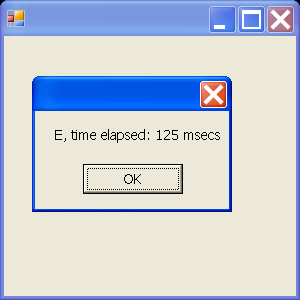Key Timer

/*
Professional Windows GUI Programming Using C#
by Jay Glynn, Csaba Torok, Richard Conway, Wahid Choudhury,
Zach Greenvoss, Shripad Kulkarni, Neil Whitlow
Publisher: Peer Information
ISBN: 1861007663
*/
using System;
using System.Drawing;
using System.Collections;
using System.ComponentModel;
using System.Windows.Forms;
using System.Data;
using System.Runtime.InteropServices;
namespace Wrox.ProgrammingWindowsGUI.Chapter5
{
/// <summary>
/// Summary description for Form1.
/// </summary>
public class KeyTimer : System.Windows.Forms.Form
{
/// <summary>
/// Required designer variable.
/// </summary>
private System.ComponentModel.Container components = null;
private uint start = 0;
private uint stop = 0;
[DllImport("kernel32.dll")]
public static extern uint GetTickCount();
public KeyTimer()
{
//
// Required for Windows Form Designer support
//
//InitializeComponent();
//
// TODO: Add any constructor code after InitializeComponent call
//
}
/// <summary>
/// Clean up any resources being used.
/// </summary>
protected override void Dispose( bool disposing )
{
if( disposing )
{
if (components != null)
{
components.Dispose();
}
}
base.Dispose( disposing );
}
#region Windows Form Designer generated code
/// <summary>
/// Required method for Designer support - do not modify
/// the contents of this method with the code editor.
/// </summary>
private void InitializeComponent()
{
//
// Form1
//
this.AutoScaleBaseSize = new System.Drawing.Size(5, 13);
this.ClientSize = new System.Drawing.Size(292, 142);
this.Name = "Form1";
this.Text = "Form1";
}
#endregion
/// <summary>
/// The main entry point for the application.
/// </summary>
[STAThread]
static void Main()
{
Application.Run(new KeyTimer());
}
protected override void OnKeyDown(KeyEventArgs args)
{
start = GetTickCount();
}
protected override void OnKeyUp(KeyEventArgs args)
{
stop = GetTickCount();
uint elapsed = (stop - start);
MessageBox.Show(Convert.ToString(args.KeyData)+", time elapsed: "+Convert.ToString(elapsed)+" msecs");
}
}
}
Related examples in the same category